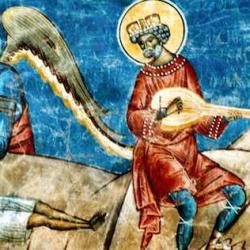Drawing from Pindar’s seventh Olympian Ode, Barbara Kowalzig (Singing for the Gods, 230-1) argues that the poem provides an etiology for the fireless sacrifice established for Athena at Rhodes. Why a sacrifice without fire, given that “as is nowhere
clearer than in Aristophanes’ Birds, on the whole it is the fire that enables a city’s
communication with the gods?”
In fact, she argues, non-burnt animal sacrifice, not to mention votive gifts of fruit and craft products, were well-known in the ancient world: “Non-burnt animal sacrifice, strange as it might
seem to the Greek eye, is not an entirely unknown practice. It was the dominant
pattern in the prehistoric Mediterranean East, that is, in Bronze Age Anatolia,
the Near East, and in Egypt, where it continued to prevail into historic times.
Similarly, whereas fire occurs regularly in Greek sacrificial iconography, Minoan
depictions, although offering abundant evidence for animal sacrifice, provide
none for the use of fire. Minoan seals, the repertoire for such imagery, feature slaughtered animals on tables, sometimes with a jar placed underneath,
suggesting a role for blood in the ritual, similar to the smearing of the altar in
Greece. Fire, however, does not feature; what happens to the dead animal is
unclear: an animal appears once in a libation scene, and elsewhere one is carried
away on a woman’s shoulder. In this respect, it is suggestive that, for example, no
Minoan altar structures have been revealed, nor have traces of burnt bones been
found in connection with the possible candidates. All there is presents evidence
for the cooking and consumption of ritual meals.”
Pindar’s poem does not, she thinks, match actual sacrificial practice, but she concludes that “it is likely that the tradition of Athena’s fireless sacrifices is
either really rooted in that milieu, or presents a conscious evocation of it. . . . the performance
of this ode does indeed evoke a special continuity from a pre-Greek past
and is interested in Rhodes’ geographical position in the eastern Mediterranean.” (238).
The aim, Kowalzig suggests, “to concentrate . . . different traditions. If [Athena] had indeed once been a deity
worshipped in the Near Eastern tradition of fireless meat sacrifice, this is perhaps
what allows her to perform this role: because of her own oscillation between a
Bronze Age tradition and an unmistakeably historic-Greek aspect, she can fit
the unrelated memories into a Greek temporal and perceptual frame and gloss
over the island’s diverse pasts and peoples (Minoans, Egyptians, Greeks) and the various groups on the island cherishing traditions of Cretans, Telkhines, Heliadai,
Akhaians” (261-2).
By linking Athena’s sacrifice to the earlier history of Rhodes, the Ode evokes a tradition, even while, in Kowalzig’s view, it introduces a ritual innovation. The song thus “orchestrates innovation through traditionalizing” (262). The khoros that sings of this ancient practice becomes itself “the performers of the fireless sacrifice.”











